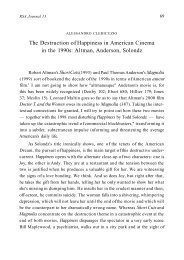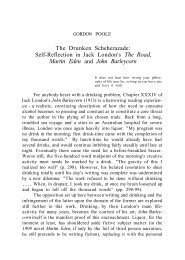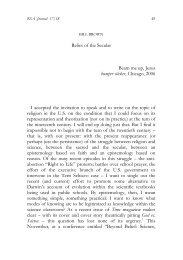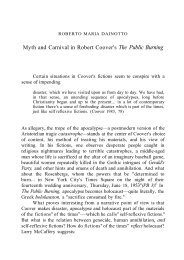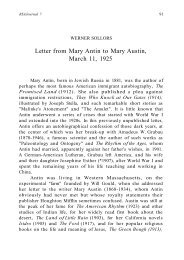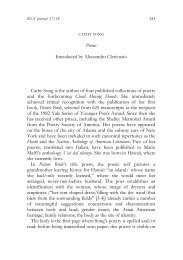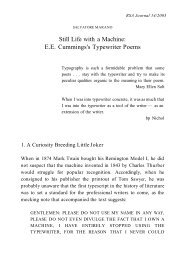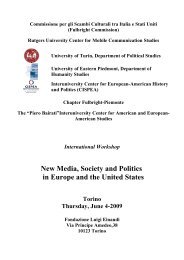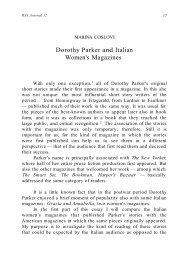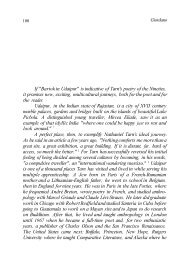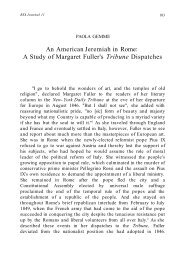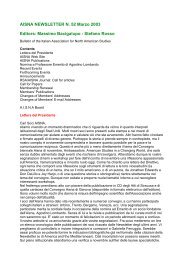“Message from the Inca” by Rudolfo A. Anaya - aisna
“Message from the Inca” by Rudolfo A. Anaya - aisna
“Message from the Inca” by Rudolfo A. Anaya - aisna
- No tags were found...
You also want an ePaper? Increase the reach of your titles
YUMPU automatically turns print PDFs into web optimized ePapers that Google loves.
<strong>Rudolfo</strong> <strong>Anaya</strong> and I had not seen each o<strong>the</strong>r for years when Ivisited him in July, 1993. After a long conversation in his office at <strong>the</strong>University of Albuquerque, he invited me to lunch in <strong>the</strong> barrio Barelas,<strong>the</strong> neighborhood where he lived for a long time. Over a cup of cinnamontea, I was telling Rudy a folk tale that my grandmo<strong>the</strong>r used to tell me,when he interrupted me and said: "Why don't you write a short story onit? If you don't, I will." In his calm and fascinating voice, <strong>the</strong> voice of atrue-born storyteller, he started to reshape my anecdote, drawing out of it<strong>the</strong> most hidden archetypal and mythical implications on <strong>the</strong> humancondition.Popular culture, legends, folklore, history, and <strong>the</strong> multifacetedmyths which become stratified in <strong>the</strong> subconscious of each person andresurface at a later stage are <strong>the</strong> main sources of <strong>Anaya</strong>'s creative writing.When I asked him <strong>the</strong> meaning of <strong>the</strong> golden carp, one of <strong>the</strong> centralsymbols in his first novel, Bless Me, Ultima, which has become a classicof Mexican American literature and sold more than 300,000 copies, Rudyreplied that he could not give me a conclusive answer. The images of fish,obviously deriving <strong>from</strong> <strong>the</strong> Christian iconography and symbolism, hadbeen in his mind since he was a child. But, later on, o<strong>the</strong>r images hadformed layers in his consciousness: <strong>the</strong> big fish that in <strong>the</strong> Bible swallowsJonah, <strong>the</strong> fish as symbol of fertility and vital energies of many Orientalreligions, <strong>the</strong> fish of <strong>the</strong> Aztec mythology which may have a positive or anegative valence. Thus, in Bless Me, Ultima <strong>the</strong> golden carp is a symbol ofChristas well as of a syncretistic divinity of <strong>the</strong> later Amerindian autochthonouscultures.When Antonio, <strong>the</strong> protagonist of <strong>the</strong> novel who relives memoriesof
84 <strong>Anaya</strong>his childhood in a prolonged flashback interspersed with his dreams, sees<strong>the</strong> golden carp, at first he is puzzled as to which of <strong>the</strong> two impliedconceptions of life he should choose. From Ultima, <strong>the</strong> healer who is hisspiritual guide, he finally learns that conflictual attitudes are <strong>the</strong> result of alimited conception of reality: what really counts is <strong>the</strong> totality of lifewhich is characterized <strong>by</strong> an interrelation of all its components.Bless Me, Ultima, <strong>the</strong> first of a New Mexico trilogy including Heartof Aztlán and Tortuga, is partly a parable of <strong>the</strong> search for identity on <strong>the</strong>part of Mexican Americans which may initially require "<strong>the</strong> rejection ofChristianity, <strong>the</strong> conqueror's religion, and a return to indigenous paganism."However, when considered in its complex, overall pattern, <strong>the</strong> novel"recovers a vision associated with a world view found in all ancientpeoples, a view which offers to modern America a mythic vision that hasbeen lost, a vision of <strong>the</strong> sanctity of all life, a vision of <strong>the</strong> beauty andeverlasting quality of <strong>the</strong> land, and a sense of <strong>the</strong> unity of life and time thattranscends <strong>the</strong> lineal, judgmental, and historical view accepted <strong>by</strong> WesternChristians" (Lattin 625-26).As a New Mexican writer, <strong>Rudolfo</strong> <strong>Anaya</strong> has been deeply influenced<strong>by</strong> <strong>the</strong> corpus of Mexican and Spanish lore—much more so than<strong>by</strong> <strong>the</strong> Anglo-Saxon cultural heritage. Consequently, as a critic put it, he"has been able to create new visions out of old realities" (Leal 335). This ishardly surprising, for among <strong>the</strong> Southwestern states New Mexico is <strong>the</strong>one where "Chicano integration into <strong>the</strong> culture of <strong>the</strong> United States had arelatively homogeneous ... development, perhaps because it was <strong>the</strong> firstto be colonized <strong>by</strong> <strong>the</strong> Spanish and <strong>the</strong> last to undergo <strong>the</strong> Anglo-Saxoncolonization" during <strong>the</strong> latter quarter of <strong>the</strong> nineteenth century (Bacchiega15; my translation).A blending of fantastic symbolism and imagery, visionary approachesto reality, magical realism, mythopoeic references, and occasional, overt,although not always successful hints to socio-political issues, is <strong>the</strong>peculiar mark of <strong>Anaya</strong>'s novels and short stories. His style, which is oftenconversational, reminds one of <strong>the</strong> storytelling of <strong>the</strong> local oral tradition.This is particularly so in <strong>the</strong> short stories. At <strong>the</strong> same time, modernfictional techniques such as stream of consciousness, interior monologue,superimposition of temporal levels, epiphanies, simultaneity of action, anda fragmented narration are also essential ingredients in his writing. <strong>Anaya</strong> isvery conscious of <strong>the</strong> problems inherent in <strong>the</strong> craft of fiction and <strong>the</strong>
RSA Journal 4 85rhetorical use of language. This is attested<strong>by</strong> <strong>the</strong> many illustrations of hisown poetics (and even of what he takes to be his failures) published as"Notes <strong>from</strong> <strong>the</strong> Author," interviews and short stories of a metafictionalnature. A case in point is "The Place of <strong>the</strong> Swallows," a story includedin<strong>the</strong> collection The Silence of <strong>the</strong> Llano, which "describes <strong>the</strong> power oflanguage and fiction to reify and to transmute <strong>the</strong> dynamic relationshipbetween life and art" (Candelaria 32). In <strong>Anaya</strong>'s words, stories "can be asimple but compelling form" and those who write <strong>the</strong>m "must be keenlyaware of styleand form . . . <strong>the</strong> aura of <strong>the</strong> storyis <strong>the</strong> vibration of time andtruth inherent in <strong>the</strong> new reality that <strong>the</strong> story creates" (<strong>Anaya</strong> 47, 49)."Message <strong>from</strong> <strong>the</strong> Inca," which <strong>Rudolfo</strong> <strong>Anaya</strong> kindly gave us forpublication in RSA Journal, is set at <strong>the</strong> time of <strong>the</strong> conquest of Cuzco <strong>by</strong><strong>the</strong> Spaniards, whom he calls "barbarians," thus reversing <strong>the</strong> conceptfound in <strong>the</strong> ancient historiography of colonization that viewed <strong>the</strong> Amerindiansas uncivilized. <strong>Anaya</strong> essentially creates an atmosphere of deepsorrow and helplessness about <strong>the</strong> fall of <strong>the</strong> Inca empire. Yet <strong>the</strong> king,who has a cyclical vision of Time, fatalistically accepts <strong>the</strong> end, knowingthat continuity is guaranteed in <strong>the</strong> form of <strong>the</strong> birth of a new era in which<strong>the</strong> Inca civilization is perpetuated.While Cuzco is under siege, a messenger of <strong>the</strong> Inca is given amessage to take to Machu Picchu which has not been, and never will be,discovered <strong>by</strong> <strong>the</strong> colonizers. During his journey, <strong>the</strong> messenger has severalvisions, one of which is a premonition of modern times—he sees anairplane and a train. Time seems to havegone mad: <strong>the</strong> messenger glimpses<strong>the</strong> harmony within nature of <strong>by</strong>gone days, and images of both futureprogress and devastation. He finally reaches Machu Picchu and delivers <strong>the</strong>quipus to <strong>the</strong> virgins of <strong>the</strong> Sun God. Then he finds himself in moderntimes, when throngs of tourists are visiting Machu Picchu, which wasdiscovered in 1911. One of <strong>the</strong> peoplepresent, an obvious metaphor for awriter, talks with <strong>the</strong> messenger who chooses to give <strong>the</strong> quipus to him.Hence <strong>the</strong> quipus, <strong>the</strong> cord used to convey messages <strong>by</strong> tying knots on it,stands for <strong>the</strong> evocative power of signs and language which eliminate <strong>the</strong>obsessive horror of nothingness through memory. <strong>Anaya</strong>'s story also impliesthat for <strong>the</strong> wheel of Time to continue to turn, it needs a drivingforce. Deathand resurrection areparts of <strong>the</strong> samecycle. The price paid forthis process may sometimes be a decline of civilization itself in relation to<strong>the</strong> initial archetype.
86 <strong>Anaya</strong>Works cited* <strong>Rudolfo</strong> A. <strong>Anaya</strong> is a prolific writer and critic. His creative works includefour novels: Bless Me, Ultima (1972), Heart of Aztlán (1976), Tortuga (1979), andAlburquerque (1992); two short novels: The Legend of <strong>the</strong> Llorona (1984) and Lord of<strong>the</strong> Dawn. The Legend of Quetzalcòatl (1987); one collection of short stories: TheSilence of <strong>the</strong> Llano (1982); an epic poem: The Adventures of Juan Chicaspatas; and atravel journal: A Chicano in China (1986). One of his short stories, "Children of <strong>the</strong>Desert," was published as "Figli del deserto" in L'Umana avventura (primavera-estate1989): 108-10, trans. di Marco Grampa. <strong>Anaya</strong> is also <strong>the</strong> author of a children's story,The Farolitos of Christmas: A New Mexico Christmas Story (1987).<strong>Anaya</strong>, <strong>Rudolfo</strong> A. "The Silence of <strong>the</strong> Llano: Notes <strong>from</strong> <strong>the</strong> Author," Melus 4(Winter 1984): 47-57.Bacchiega, Franca. Sotto il quinto sale. Firenze: Passigli, 1990.Candelaria, Cordelia. "<strong>Rudolfo</strong> A. <strong>Anaya</strong>," Chicano Writers. First series. Eds. FranciscoA. Lomeli and Carl R. Shirley. Dictionary of Literary Biography 82.Detroit: Gale, 1989.Lattin, Vernon E. "The Quest for Mythic Vision in Contemporary Native Americanand Chicano Fiction," American Literature 50.4 (1979): 625-40.Leal, Luis. "Voices in <strong>the</strong> Wind: <strong>Anaya</strong>'s Short Fiction," <strong>Rudolfo</strong> A. <strong>Anaya</strong>: Focus onCriticism. Ed. César A. González. La Jolla: Lalo Press, 1990: 335-48.



